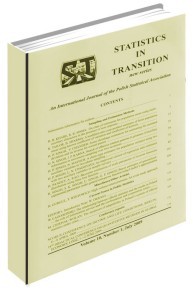UNIVARIATE SAMPLE SIZE DETERMINATION BY ALTERNATIVE COMPONENTS: ISSUES ON DESIGN EFFICIENCY FOR COMPLEX SAMPLES
UNIVARIATE SAMPLE SIZE DETERMINATION BY ALTERNATIVE COMPONENTS: ISSUES ON DESIGN EFFICIENCY FOR COMPLEX SAMPLES
Author(s): Ceylan Talu Yozgatligil, H. Öztaş AyhanSubject(s): Economy, Sociology, Public Finances, Socio-Economic Research
Published by: Główny Urząd Statystyczny
Keywords: univariate sample size; representation bias; sample allocation; error statistics; design efficiency measures
Summary/Abstract: Sample size determination for any sample survey can be based on the desired objectives of the survey as well as the level of confidence of the desired estimates for some survey variables, the desired precision of the survey results and the size of the population. In addition to these, the cost of enumeration can also be considered as an important criterion for sample size determination. Recently, some international organizations have been using univariate sample size determination approaches for their multivariate sample designs. These approaches also included some design efficiency and error statistics for the determination of the univariate sample sizes. These should be used for determining the survey quality measures after the data collection, not before. The additional components of the classical sample size measure will create selection and representation bias of survey estimates, which is discussed in this article.
Journal: Statistics in Transition. New Series
- Issue Year: 19/2018
- Issue No: 2
- Page Range: 201-218
- Page Count: 18
- Language: English

